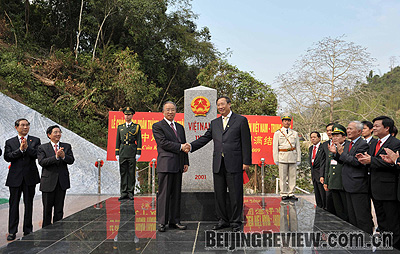| Chinese and Vietnamese officials unveiled new boundary markers on February 23. The ceremony, held at the Youyiguan border gate in Pingxiang City in south China's Guangxi Zhuang Autonomous Region, marked the completion of the land border demarcation and erection of boundary markers between China and Viet Nam.
 |
|
JOINT EFFORT: Chinese State Councilor Dai Bingguo (left) and Vietnamese Deputy Prime Minister and Foreign Minister Pham Gia Khiem shake hands after unveiling a new boundary marker in Pingxiang, Guangxi Zhuang Autonomous Region on February 23 (ZHOU HUA) | More than 400 representatives from foreign affairs, defense, public security, surveying and mapping and economic agencies of both countries as well as local governments along the border attended the ceremony. Chinese State Councilor Dai Bingguo and Vietnamese Deputy Prime Minister and Foreign Minister Pham Gia Khiem spoke on behalf of their respective governments. The move brought the two countries' land border issue to a satisfying end and will have positive implications for the future development of their bilateral relations.
Winding path to settlement
In retrospect, China and Viet Nam traveled a long, winding path to resolve their land border issue in the spirit of respect for both history and the present, candid consultation and mutual accommodation.
The land border between China and Viet Nam runs from the intersection of China, Viet Nam and Laos in the west to the mouth of the Beilunhe River in the east, stretching more than 1,300 km through Yunnan Province and Guangxi Zhuang Autonomous Region in China and Cao Bang, Lang Son, Dien Bien, Lai Chau, Lao Cai, Ha Giang and Guang Ninh provinces in Viet Nam.
Despite the absence of a clear-cut border between China and Viet Nam before the 19th century, the two countries did not have a border issue in the modern sense as both observed a conventional boundary. Their border was not formally demarcated until the French colonial government in Viet Nam and the government of the Qing Dynasty of China signed border treaties in 1887 and 1895. More than 300 boundary markers were planted under the treaties. Over the past century, many boundary markers have been destroyed, moved or lost. Dramatic changes in their political and social landscapes as well as in their bilateral relations have also factored in, resulting in severe border disputes between the two countries.
China and Viet Nam carried out negotiations on border demarcation and territory in the mid-1970s without success. The negotiations were suspended after the two countries' relations grew hostile, and were not resumed until they normalized relations in 1991. Negotiations were conducted between Chinese and Vietnamese experts in 1992. The following year, the two countries' top leaders decided to launch governmental negotiations on the issues of border demarcation and territory, with land border demarcation being one of the three objectives of the negotiations. Representatives of the two countries' governments signed an agreement on the basic principles of resolving their border and territory issues in October 1993. Both countries agreed to reestablish a border treaty based on the land boundary delineated by the French colonial government in Viet Nam and the Qing Dynasty.
The China-Viet Nam joint working group held 16 rounds of negotiations in Hanoi and Beijing from 1994 to 1999. Negotiators found that about 900 km of the border were commonly recognized. Along the remaining 450 km, there were 164 disputed areas totaling some 227 square km. Negotiations focused squarely on these areas. In the negotiations, Chinese and Vietnamese experts bridged their differences in a reasonable manner according to the guiding principles agreed upon by the two countries' leaders. By the end of 1999, they had finished demarcating all the disputed areas, paving the way for the signing of the Treaty of Land Border between China and Viet Nam on December 30, 1999 by the two countries' governments. Their parliaments-the National People's Congress of China and the National Assembly of Viet Nam-ratified the treaty the following year.
|
